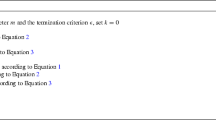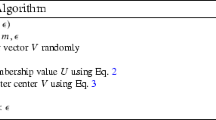Abstract
Fuzzy C-mean (FCM) is an algorithm for data segmentation and classification, robust and very popular within the scientific community. It is used in several fields such as computer vision, medical imaging and remote control. The purpose of this paper is to propose a parallel implementation of the iterative type-2 fuzzy C-mean (IT2FCM) algorithm on a massively parallel SIMD architecture to segment different MRI images. IT2FCM is an FCM standard variant; its objective is identical to that of FCM, except that the first has a higher accuracy level than the second. However, it is expensive in terms of time processing. Therefore, it is practically important to reduce its execution time while preserving the quality of the segmentation. This implementation is then compared with the sequential versions in the C language and Python using the Numpy and Numba libraries, and then, we compared it to another parallel method from the literature. The execution time obtained is faster than the sequential versions by about 15 × and 4 × for the second parallel version. The results achieved are very satisfactory compared to those taken from the literature.










Similar content being viewed by others
References
PRINCE, Jerry L. and LINKS, Jonathan M. Medical imaging signals and systems. Upper Saddle River : Pearson Prentice Hall, 2006.
Lee LK, Liew SC, Thong WJ (2015) A Review of Image Segmentation Methodologies in Medical Image. In: Sulaiman H, Othman M, Othman M, Rahim Y, Pee N (eds) Advanced Computer and Communication Engineering Technology. Lecture Notes in Electrical Engineering, vol 315. Springer, Cham. https://doi.org/10.1007/978-3-319-07674-4_99.
Singh K, Malik D, Sharma N (2011) Evolving limitations in K-means algorithm in data mining and their removal. Int J Comput Eng Manag 12(1):105–109
Almutairi S, Manimurugan S, Aborokbah M (2019) A new secure transmission scheme between senders and receivers using HVCHC without any loss. Journal on Wireless Communications and Networking https://doi.org/10.1186/s13638-019-1399-z
Mustafa M, Abdalla GMT, Manimurugan S et al (2020) Detection of heartbeat sounds arrhythmia using automatic spectral methods and cardiac auscultatory. J Supercomput 76:5899–5922. https://doi.org/10.1007/s11227-019-03062-7
Ahmed MN, Mohamed NA, Farag AA, Moriarty T (2002) A modified fuzzy c-means algorithm for bias field estimation and segmentation of MRI data. IEEE Trans Med Imaging 21:193–199. https://doi.org/10.1109/42.996338
Kalaiselvi T, Somasundaram K (2011) Fuzzy c-means technique with histogram based centroid initialization for brain tissue segmentation in MRI of head scans. In: 2011 international symposium on humanities, science and engineering research, pp 149–154.
Kalaiselvi T, Somasundaram K (2014) Knowledge based self-initializing FCM algorithms for fast segmentation of brain tissues in magnetic resonance images. Int J Comput Appl 90(14):19–26
Chuang KS, Tzeng HL, Chen S, Wu J, Chen TJ (2006) Fuzzy c-means clustering with spatial information for image segmentation. Comput Med Imag Graph 30(1):9–15. https://doi.org/10.1016/j.compmedimag.2005.10.001
MENDEL, Jerry M. Uncertain rule-based fuzzy systems. Introduction and new directions, 2017, p. 684.
Mendel J, John R (2002) Type-2 fuzzy set made simple. IEEE Trans Fuzzy Syst 10(2):117–127
Mendel J (2004) “Computing derivatives in interval type-2 fuzzy logic systems”,IEEE Trans. Fuzzy Syst 12(1):84–98
J. Mendel and R. John, “A fundamental decomposition of type-2 fuzzy sets,” in Proc. 2001 Joint Conf. IFSA/NAFIPS, Jul. 2001, pp.1896–1901
Liu X, Ounifi HA, Gherbi A et al (2020) A hybrid GPU-FPGA based design methodology for enhancing machine learning applications performance. J Ambient Intell Human Comput 11:2309–2323. https://doi.org/10.1007/s12652-019-01357-4
Engel TA, Charao AS, Kirsch-Pinheiro M, Steffenel LA (2015) Performance improvement of data mining in Weka through multi-core and GPU acceleration: opportunities and pitfalls. J Ambient Intell Human Comput 6(4):377–390
Hwang C, Rhee, FCH (2007) Uncertain fuzzy clustering: Interval type-2 fuzzy approach to $ c $-means. IEEE Transactions on fuzzy systems, 15(1):107-120.
Eklund A, Dufort P, Forsberg D, LaConte SM (2013) Medical image processing on the gpu–past, present and future. Med Image Anal 17(8):1073–1094
Nouredine AITALI, Bouchaib CHERRADI, Ahmed EL ABBASSI,Omar BOUATTANE and Mohamed YOUSSFI, (2016). “Parallel Implementation of Bias Field Correction Fuzzy C-Means Algorithm for Image Segmentation”International Journal of Advanced Computer Science and Applications(IJACSA), 7(3):367–374.
Rowińska Z, Gocławski J (2012) Cuda based fuzzy c-means acceleration for the segmentation of images with fungus grown in foam matrices. Image Process Commun 17(4):191–200. https://doi.org/10.2478/v10248-012-0046-7
Alsmirat MA, Jararweh Y, Al-Ayyoub M, Shehab MA, Gupta BB (2017) Accelerating compute intensive medical imaging segmentation algorithms using hybrid CPU-GPU implementations. Multimedia Tools Appl 76(3):3537–3555. https://doi.org/10.1007/s11042-016-3884-2
Shehab M, Al-Ayyoub M, Jararweh Y, Jarrah M (2016) Accelerating compute-intensive image segmentation algorithms using GPUs. J Supercomput 73(5):1929–1951. https://doi.org/10.1007/s11227-016-1897-2
Aitali N. Cherradi B, El abbassi A, Bouattane O and Youssfi M (2016) GPU based Implementation of Spatial Fuzzy C-means Algorithm for Image Segmentation. In the Procceding of the 4th IEEE International Conference on Information Science and Technology (CiSt’16): 460–464. https://doi.org/10.1109/CIST.2016.7805092
Harris C & Haines K (2005) Iterative Solutions using Programmable Graphics Processing Units. In FUZZ-IEEE:12–18.
Anderson D, Luke RH, Keller JM (2007) Incorporation of non-euclidean distance metrics into fuzzy clustering on graphics processing units. Analysis and Design of Intelligent Systems using Soft Computing Techniques. Springer, Berlin Heidelberg, pp 128–139
Shalom SA, Dash M, & Tue M (2008) Graphics hardware based efficient and scalable fuzzy c-means clustering. In Proceedings of the 7th Australasian Data Mining Conference. Volume 87: 179–186.
Hong-tao B, Li-li H, Dan-tong O, Zhan-shan L, He L (2009) K-Means on commodity GPUs with CUDA. WRI World Congress on Comput Sci Inf Eng 2009:651–655. https://doi.org/10.1109/CSIE.2009.491
Zechner M, Granitzer M (2009) Accelerating K-Means on the graphics processor via CUDA. First Int Conf Intensive Appl Serv 2009:7–15. https://doi.org/10.1109/INTENSIVE.2009.19
Pangborn AD (2010) Scalable data clustering using gpus. Thesis. Rochester Institute of Technology. Accessed from http://scholarworks.rit.edu/theses/5464.
Wu J, Hong B (2011) An efficient k-means algorithm on CUDA. IEEE Int Symp Parallel Distrib Process Worksh Phd Forum 2011:1740–1749. https://doi.org/10.1109/IPDPS.2011.331
Ngo LT, Mai DS, Nguyen MU (2012, November). GPU-based acceleration of interval type-2 fuzzy c-means clustering for satellite imagery land-cover classification. In 2012 12th International Conference on Intelligent Systems Design and Applications (ISDA) (pp. 992-997). IEEE
Li H, Yang Z, He H (2014) An improved image segmentation algorithm based on GPU parallel computing. J Softw 9(8):1985–1990. https://doi.org/10.4304/jsw.9.8.1985-1990
Al-Ayyoub M, Abu-Dalo AM, Jararweh Y, Jarrah M, Al Sad M (2015) A GPU-based implementations of the fuzzy C-means algorithms for medical image segmentation. J Supercomput 71(8):1–14. https://doi.org/10.1007/s11227-015-1431-y
Ngo LT, Nguyen DD, Luong, CM (2012) Speedup of interval type 2 fuzzy logic systems based on GPU for robot navigation. Advances in Fuzzy Systems, 2012. https://doi.org/10.1155/2012/698062
Sriramakrishnan P, Kalaiselvi T, Somasundaram K, Rajeswaran R (2019) A rapid knowledge‐based partial supervision fuzzy c‐means for brain tissue segmentation with CUDA enabled GPU machine. International Journal of Imaging Systems and Technology, 29(4):547-560.
AitAli N, Cherradi B, El Abbassi A et al (2018) GPU fuzzy c-means algorithm implementations: performance analysis on medical image segmentation. Multimed Tools Appl 77:21221–21243. https://doi.org/10.1007/s11042-017-5589-6
Cook S (2012) CUDA programming: adeveloper’s guide to parallel computing with GPUs. Elsevier Books, Amsterdam
Author information
Authors and Affiliations
Corresponding author
Additional information
Publisher's Note
Springer Nature remains neutral with regard to jurisdictional claims in published maps and institutional affiliations.
Rights and permissions
About this article
Cite this article
Ali, N.A., abbassi, A.E. & Cherradi, B. The performances of iterative type-2 fuzzy C-mean on GPU for image segmentation. J Supercomput 78, 1583–1601 (2022). https://doi.org/10.1007/s11227-021-03928-9
Accepted:
Published:
Issue Date:
DOI: https://doi.org/10.1007/s11227-021-03928-9




